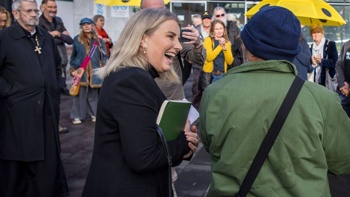
“Is the dam worth persisting with?” Councillor Peter Johns asked the question at a Tararua District Council meeting this week.
Councillors were given an update on Dannevirke’s impounded supply, which has been under investigation for leaks and seepage for more than 18 months.
In July 2021, it was discovered that the dam, which was completed in 2013, was leaking.
Investigations found splits in the liner and it was thought by Christmas 2021 that those leaks had been repaired - while the repairs reduced the loss of water, they did not stop it completely.
In May last year, experts were contracted to undertake further investigations and make recommendations.
A report was given to the council and in September funding of $1,085,000 was approved to progress planning for permanent repairs and improvements.
Council Three Waters manager Jean de Villiers said the project had evolved a little bit.
“We need to understand the overall strategy and there’s a number of opportunities that we’re looking at.”
De Villiers said part of the strategy was in what resilience would look like in the future.
“We also need to think about growth and levels of service.”
Senior programme manager Roger Earp said it was important to reinforce that it was not just the dam itself they were dealing with.
“Obviously we’ve got a dam that’s leaking. We’ve got a cover that needs some repairs and we’ve got some hydraulic oversights in terms of how the original dam was designed. We’ve also got some strategic issues around a single water source.”
He said there were also increasing challenges around turbidity, which restricted the ability to use the impounded supply to full effect.
New dam legislation due to take effect in May next year would also have “significant implications” on how the impounded supply was managed in future.
Earp said one of the biggest challenges was in quantifying the extent of the damage to the dam.
“With the cover, it makes it really difficult to get a good look inside and really know what’s going on.”
He said there would be some geotechnical investigations and another submersible sonar device would be put into the dam to take another look and compare images with those from two years ago to assess what’s happened.
“The other piece of the puzzle is the extent of the risk that we’re carrying in terms of the likelihood of the impounded supply having uncontrolled release. We’re also trying to balance that and ensure that we have adequate steps in place to be able to pick up any indicators that the current condition of the dam is deteriorating.”
An optioneering workshop was scheduled for mid-April where experts would report back on possible options and assess the implications.
/cloudfront-ap-southeast-2.images.arcpublishing.com/nzme/IT4VLFZQEBBRFM7O3IIQBFXYJA.jpg) Tracey Collis, Bryan Nicholson, Chris Chapman, Jean de Villiers and Kerry Sutherland at the public meeting on the dam last year. Photo / Leanne Warr
Tracey Collis, Bryan Nicholson, Chris Chapman, Jean de Villiers and Kerry Sutherland at the public meeting on the dam last year. Photo / Leanne Warr
Councillors had a number of concerns and councillor Kerry Sutherland asked about water levels.
“What is the actual level by which we can’t extract? What is the level where once we hit that we’re in trouble?”
Infrastructure manager Chris Chapman, who was acting as chief executive at the meeting, said submersible pumps were used below the 6m mark which could extract 20 litres per second instead of the usual 50-60 litres per second.
“We can’t take Dannevirke’s full consumption out of the impounded supply when it gets below 6m but we can take some out.”
Councillor Peter Johns queried the design work for the pre-treatment facility, asking if they were designing something that had already been done for other areas of the Tararua District.
He also questioned the future of the dam.
“If we can’t extract two-thirds of the water in that dam, what’s the point in persisting with it?”
He said 20 litres per second with submersible pumps seemed to be an expensive way of getting water, as well as risky.
“Are we not better to cut our losses and go for a tank farm?”
Chapman said in terms of pre-treatment, there was only one plant that was able to treat high turbidity levels, and that was in Pahiatua.
He said the facility that was being designed would be something different from anything currently in the district.
In terms of the impounded supply, “is it a dead duck”? Chapman said.
“That’s where we need to come up with options for you guys to make a well-informed educated decision on what is the best long-term solution.
“We’re certainly not writing it off yet.”
Chapman said they did need to get facts on what the various options were and all of the long-term implications to enable councillors to make the best decision.
He said those options would come with consequences and they needed to make sure the council was clear on what those were.
De Villiers said the impounded supply had proven its worth with Cyclone Gabrielle and some very careful decisions needed to be made.
“It’s a huge piece of infrastructure that has massive value.”
While a tank farm was part of considerations for an alternative storage facility, he said that to try to replace the volume of water the impounded supply held would not be economical.
A report was expected to be submitted to the council by May.
Take your Radio, Podcasts and Music with you









